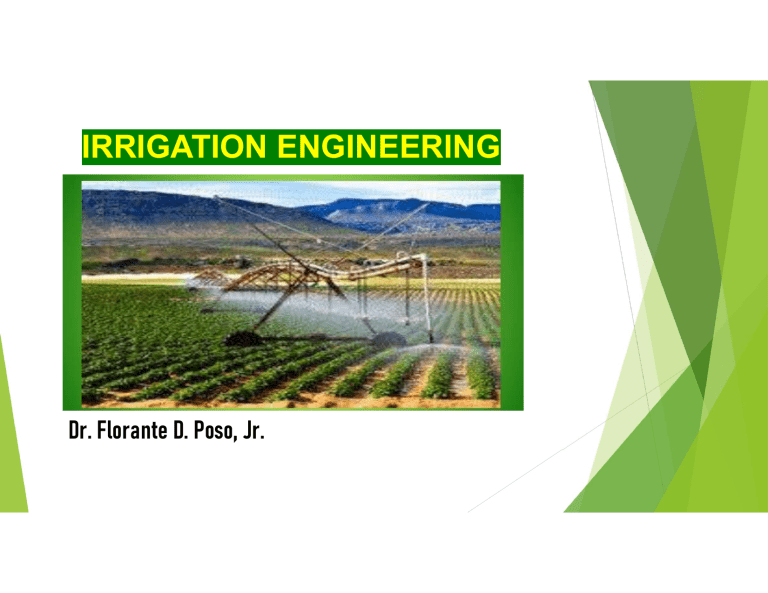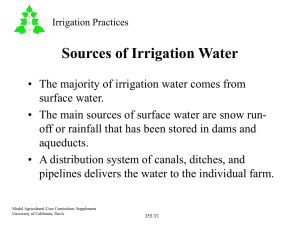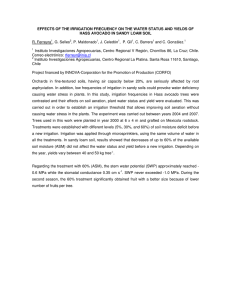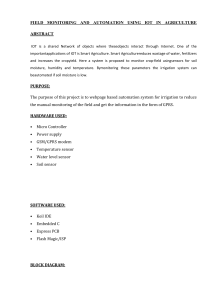
IRRIGATION ENGINEERING Dr. Florante D. Poso, Jr. Irrigation Water Water Administration Soil for Irrigation IRRIGATION ENGINEERING Irrigation is the application of water to the soil to supplement natural precipitation and provide an environment that is optimum for crop production. OBJECTIVES OF IRRIGATION To Supply Water Partially or Totally for Crop Need To Cool both the Soil and the Plant To Leach Excess Salts To improve Groundwater storage To Facilitate continuous cropping To Enhance Fertilizer Application- Fertigation IRRIGATION The process of artificial application of water to the soil for the growth of agricultural crop. IRRIGATION A science of planning and designing a water supply system for agricultural land to protect the crops from bad effect of drought or low rainfall. Necessity of Irrigation a) Insufficient rainfall b) Uneven distribution of rainfall c) Improvement of perennial crops yield d) Development of agriculture in the desert areas e) Insurance of drought Direct Benefit of irrigation Increase in crop yield Protection of famine Improvement of cash crops Elimination of mixed cropping Prosperity of farmers Source of revenue Overall development of the nation Indirect Benefits of Irrigation Hydroelectric development Indirect Benefits of Irrigation Flood control Indirect Benefits of Irrigation Domestic and industrial water supply Indirect Benefits of Irrigation Navigation Indirect Benefits of Irrigation Development of fishery Indirect Benefits of Irrigation Ground water recharges Ill-effects of Irrigation Raising of water Table Ill-effects of Irrigation Formation of marshy area Ill-effects of Irrigation Soil erosion Ill-effects of Irrigation Loss of valuable lands Ill-effects of Irrigation Loss of soil fertility Ill-effects of Irrigation Dampness of weather Production of harmful gases To Understand Irrigation, One Needs Knowledge of: Basic Soil Science/Physics Plants Water Plant/Soil/Water Relations Hydraulics Hydrology General Engineering Principles IRRIGATION: The process of artificial application of water to the soil for the growth of agricultural crop. A science of planning and designing a water supply system for agricultural land to protect the crops from bad effect of drought or low rainfall. It includes the following structures for the regular supply of water to the required command area: Weir/barrage Dam/reservoir Canal system - The quantity of water used for the artificial application to the soil through various systems of tubes, pumps, and sprays. Irrigation is usually used in areas where rainfall is irregular or dry times or drought is expected. Irrigation water supply mainly depends on the surface and ground water resources. For surface irrigation, river water needs to be diverted from the river, which significantly alters the river's flow regime and thus the river ecology in terms of both biotic and abiotic components. Irrigation is the process through which controlled amount of water can be supplied through artificial means such as pipes, ditches, sprinklers etc. the main ... Irrigation helps to grow agricultural crops, maintain landscapes, and revegetate disturbed soils in dry areas and during periods of less than average rainfall. To plan, direct, and supervise the Water Systems Operations; including pumping, storage, transmission, purification, treatment, and distribution of City water. - Water management is the whole of activities that aims to plan, develop, distribute and make optimum use of ground, surface ... Soil-plant Water relationships relate the properties of soil that affect the movement, retention and use of water. It can be divided & treated as: Soil-water relation Soil-plant relation Plant-water relations SOIL-WATER RELATIONSHIPS Soil Suitability for agricultural practices Knowledge of the soils within a potential irrigation area is essential for economic and technical reasons. SOIL Is a three-dimensional body occupying the upper part of the earth’s crust and having properties differing from the underlying rock material as a result of interactions between climate, living organism, parent material and relief and which is distinguished from other soils in terms of differences in internal characteristics and/or in terms of the gradient slope-complexity, micro topography, stoniness, and rockiness of the surface. FIGURE 1- DIAGRAM SHOWING CROSS SECTION OF SOIL Water film Air space Soil particles The suitability of soil for agricultural practices may be affected by physical and chemical soil characteristics. The physical characteristics include: 1. Effective Soil Depth 6. Soil Structure 2. Water Holding Capacity 7. Soil Consistence 3. Non-capillary Porosity 8. Soil Permeability 4. Topography and 5. Texture Hydraulic Conductivity Permeability - is the ease with which liquids, gases and roots pass through the soil. Hydraulic conductivity is the permeability of the soil for water. i.e. the ease with which the soil pores permit water movement. It controls the soil water movement. Soil Suitability for agricultural practices Table 2.1: Size limits of soil separates Source: United States Department of Agriculture (USDA) and the International Soil Science Society (ISSS) Soil separates Very course sand Course sand Medium sand Fine sand Very fine sand Silt Clay Particle diameter (mm) USDA ISSS 2.0 - 1.0 1.0 - 0.5 2.0 - 0.2 0.50 - 0.25 0.25 - 0.10 0.20 - 0.02 0.10 - 0.05 0.05 - 0.002 0.02 - 0.002 < 0.002 < 0.002 Soil Suitability for agricultural practices Fig. 2.3: USDA textural triangle It means that physical properties of soil in relation to water. The rate of entry of water in to the soil and its retention, movement and availability to plant roots are all physical phenomena. Hence, it is important to know the physical properties of soil in relation to water. Water can exist in either of the following forms in the soil. 1. Gravitational water 2. Capillary water 3. Hygroscopic water The following soil moisture contents are of significance importance in agriculture and are termed soil moisture constants. 1. Saturation Capacity 2. Field capacity 3. Permanent Wilting Point The soil moisture tension at PWP ranges from 7 to 32 atm, depending on the soil texture, kinds of crops and salt content in the soil solution. - Since the change in moisture content (∆q) is insignificant for changes in SMT from 7-32 atm. Hence, 15 atm. is taken as SMT at PWP. - At PWP the plant starts wilting, and if no water is given to the plant, then it will die. 1. Total available water, TAW The soil moisture between field capacity and permanent wilting point is called available water. This is the water available for plant use. Finegrained soils generally have a wider range of available moisture than course textured soil. 2. Management allowed deficit, MAD. The degree to which the volume of water in the soil is allowed to deplete before the next irrigation is applied. That is portion of the available moisture, which is easily extracted by the plant roots. It is commonly 60 – 80 % of the available water. MAD = f. TAW, f depends on type of crop and Crop growing stage. 3. Soil moisture deficit, SMD. The depletion of soil moisture below field capacity at the time that particular soil moisture content, qv , is measured. That is the amount of water required to bring the soil moisture back to the field capacity. Deficit = Fc – soil moisture at that instant. Figure 2.1: Soil moisture levels and available water ranges. Soil moisture levels and available water ranges. The salt concentration in the water extracted from a saturated soil (called saturation extract) defines the salinity of this soil. If this water contains less than 3 grams of salt per litre, the soil is said to be non saline (see Table below). If the salt concentration of of thethesaturation extract contains more than 12 Salt concentration soil water (saturation g/l, the soil is saidextract) to be highly saline Salinity in g/l in millimhos/cm 0-3 3-6 0 - 4.5 4.5 - 9 non saline slightly saline 6 - 12 more than 12 9 - 18 more than 18 medium saline highly saline Crops and saline soils Most crops do not grow well on soils that contain salts. One reason is that salt causes a reduction in the rate and amount of water that the plant roots can take up from the soil (see Fig. 105). Also, some salts are toxic to plants when present in high concentration. METEOROLOGY AND HYDROLOGY Air temperature Relative humidity Precipitation Wind Direction Solar Radiation Soil Temperature Barometric Pressure Soil Moisture System of Irrigation IRRIGATION SYSTEMS Lift Irrigation Using man or Animal power Using Mechanical or Electrical Power Flow Irrigation Inundation Irrigation Direct Irrigation Perennial Irrigation Storage Irrigation Lift Irrigation Flow Irrigation Method of Distribution of Irrigation Water Method of Distribution Surface Methods Furrow Method Sprinkler Methods Overhead Irrigation Sub-Surface Methods (Drip) Contour Farming Method Flooding Method Uncontrolled Flooding Free Flooding Controlled Flooding Basin Flooding Check Flooding Border Strip Surface Method of Irrigation The irrigation method is distributed to the agricultural land through the small channels, which flood the area up to the required depth. Surface Method of Irrigation Sub-Surface Method The water is applied to the root zone of the crops by underground network of pipes . Sub-Surface Method Sprinkler Irrigation Method The water is applied to the land in the form of spray like rain. Sprinkler Irrigation Method Feasibility studies of irrigation projects Necessity for irrigation in the region Availability of adequate water supply Topography of the area Cultural practices of the tract Adequacy of existing irrigation system if any Possibility of growing cash crops or other voluble crops after provision of irrigation water Accessibility to the project site (transportation, Communications and other required facilities) and construction materials. Economical justification for implementing the irrigation scheme. Data to be collected (Feasibility Study) 1. Physical data 2. Hydrological data 3. Agricultural data 4. Geological data 5. Cartographic data 6. Ecological data 7. Demographic data 8. Economic data 9. Legal data 10. Data in existing project 11. Data on public opinion 12. Flood control data





